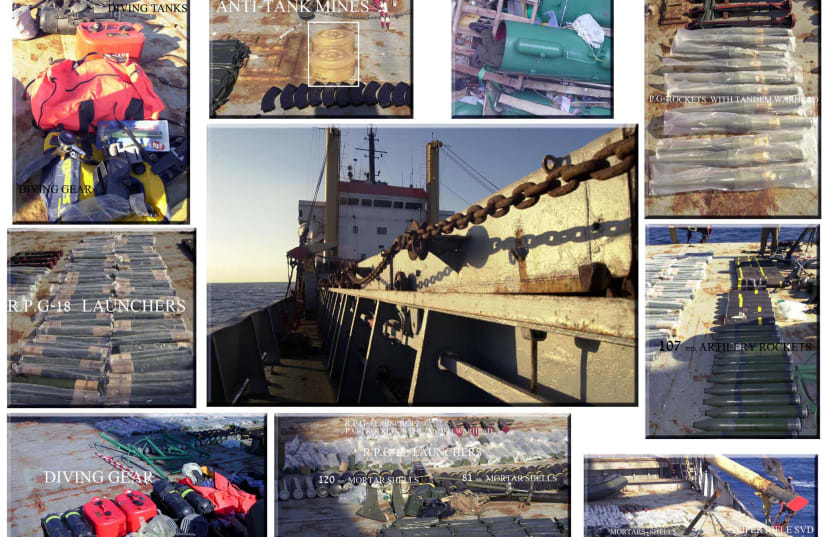This scene, familiar from countless Hollywood films, was not written by a scriptwriter. No director shouted “Cut” when the action was over. Code-named “Noah’s Ark,” the maneuvers were part of a real operation carried out by Israeli Navy commando teams on January 3, 2002. The purpose of the mission was to capture the Karine A, a Palestinian Authority freighter carrying 55 tons of arms and explosives – a cargo that would fuel the fires of the Second Intifada that had already consumed so many Israeli and Palestinian lives.
Taking over the ship was merely the first step in a complex operation that began five months earlier, after Israeli intelligence agencies picked up signs indicating the purchase of a freighter by Palestinian-Hezbollah operatives. An intricate series of events followed in which highly sophisticated means of collection combined with traditional qualities necessary in the intelligence game: curiosity, discernment and intuition.
The author of A Raid on the Red Sea, Brig.-Gen. (ret.) Amos Gilboa, served as the head of Israel’s Military Intelligence Research Department from 1982-1984, and continued studying the history of Israeli intelligence after retirement. He died shortly before the book came out in English. Gilboa knew how to tell a story, with editing and translation into English by The Jerusalem Post’s legal and defense correspondent Yonah Jeremy Bob. Moreover, Gilboa’s intimate acquaintance with the way intelligence special ops were conducted in Israel enabled him to produce an authentic and fascinating account of a dramatic chapter in Israel’s military history.
Part of the story takes place in the offices of Naval Intelligence, where young analysts, some of whom had graduated from high school only two years earlier, monitor activity around the boat, track its identity and locate it in Port of Dubai. This departure point presented the Israelis with an operational problem. Locating the Karine A in the Red Sea was relatively easy, although the navy had better operational capabilities in the Mediterranean. One solution was to get the Americans to capture the ship in the Red Sea as part of their war on terrorism. The Americans, however, while agreeing to assist with intelligence, refused to involve their forces in the takeover of the ship.
Assembling the intelligence needed for the operation was an exceedingly demanding task. As is usually the case, the intelligence information regarding the location of the freighter – whether it had already left the Port of Dubai and what its destination would be – was partial and contradictory. Nevertheless, the operation was green-lighted by military and political decision-makers, and Operation Noah’s Ark commenced.
The operation was the first of its kind. Never before had commando teams captured a moving ship by simultaneously scaling its deck from the sea and landing on it from the air. In typical Israeli fashion, the maneuvers were carried out under a heavy veil of secrecy, under incredible time pressure, with insufficient information and, crucially, using a lot of improvisation. (That can only take place in a milieu in which officers from different branches know and trust each other, and are licensed to follow their own intuitions and initiatives).
Here’s one typical episode. Fast ropes were a critical element for the success of the operation. But at the last moment, it became clear that the ropes were not up to standards. The officer in charge of the helicopter force discovered there were ropes in storage near Tel Aviv, but the warehouseman refused to give them without a proper authorization.
Since the operation was conducted under heavy secrecy, the officer could not ask for external help. Instead, he called the warehouseman and told him that in 10 minutes a helicopter would fly over the storage facility and turn on its lights. Ten minutes later, a helicopter hovered overhead and shined its lights, convincing the stunned warehouseman to cooperate. He then brought the ropes to a nearby heliport, where they were collected by the same helicopter that delivered them to the naval commando base. The show could go on.
Ultimately, and despite the many difficulties and obstacles, the operation was a complete success. The Karine A crew were taken completely by surprise, and the takeover was concluded without a single shot being fired. The arms shipment found on the boat carried marks of Iran’s Islamic Revolutionary Guard Corps. The operational success was translated by prime minister Ariel Sharon into a diplomatic one, turning Palestinian leader Yasser Arafat, who cooperated in the venture with Iran, into a pariah in the eyes of the Bush administration, leading to a change in US policy (though not necessarily improving the chance for peace).
Fiction and nonfiction literature on special operations have become highly popular in recent years. For anyone interested in the subject, this well-written, authoritative and fascinating account of a daring raid in the Red Sea is a must.
The writer is a professor (emeritus) at the University of Haifa.
A RAID ON THE RED SEA: THE ISRAELI CAPTURE OF THE KARINA A
By Amos Gilboa,
edited and translated by Yonah Jeremy Bob
Potomac Books, 2021
277 pages
